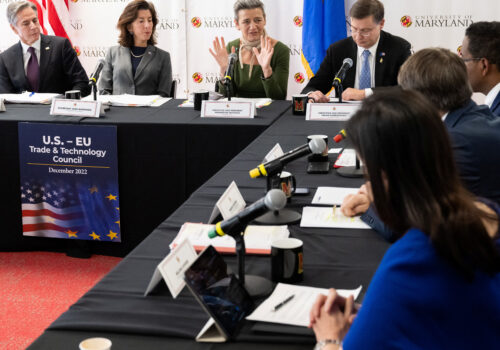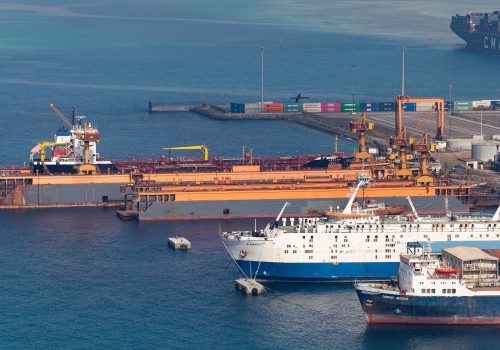Climate, drought, and the disrupted future of global trade
Over 80 percent of all global trade in goods and commodities is carried through waterways. But climate change threatens the efficient functioning of waterways, canals, and seaports—and therefore is a major threat to global trade. The most commonly discussed way that climate change can disrupt waterborne trade is drought, which can lower water levels in critical waterways such as the Panama Canal to the point where large cargo ships can’t get through. But drought is not the only mechanism through which climate change will affect global trade. Global warming and the subsequent rising sea levels and higher frequency and intensity of extreme weather conditions are also threatening the functionality of many seaports around the world. At the same time, the warming atmosphere is opening new trade routes through the Arctic and by doing so is creating new fronts for geopolitical tension. If governments can’t find a way of cooperating to address these concerns, trillions of dollars in global trade could be disrupted.
Rivers and canals
The Panama Canal services 50 percent of trades from Asia to the US east coast and a yearly merchandise value of $500 billion, two-thirds of which goes to the United States. Given the unprecedented droughts in that region and lower water levels in the Canal, the authorities have restricted the number of vessels that can pass through each day by 50 percent. Many vessels have fully given up on using the canal in favor of traveling around the Cape of Good Hope, increasing the cost of dry bulk shipping by approximately 14 percent compared to the previous year.
The current shipping crisis in the Panama Canal is not an anomaly. In the future, the Canal may only be functional at full capacity for three to four months of the year. Panama Canal Administrator Ricaurte Vasquez Morales explained last year, “This is a new reality that is not unique to the Panama Canal; it’s something that you’re seeing in some other rivers in Europe, it’s something that you’re seeing in the Mississippi… Climate change is essentially the reason why this is happening.”
Morales is not wrong. The Mississippi river, through which flows 60 percent of US grain shipments and 22 percent of oil and gas exports, faced the same challenge in September 2022 with a drought that increased grain shipment prices by 400 percent compared to the average, in turn raising the price of delivered soybeans by 24 percent. Just a month earlier and in another part of the world, a drought in China’s Yangtze decreased the river’s width by half. The Yangtze is critical for connecting cities like Chongqing and Wuhan with major coastal ports like Shanghai. After the August drought, container export volumes fell by 8 percent along the river, and the transit period from Chongqing to Shanghai increased by three times. Other examples include drought-related shipping bottlenecks along the Rhine River in Europe and rivers in the Amazon, all of which are creating significant challenges for the local economies with ripple effects on the global economy.
Seaports
There are more than 3,800 commercial seaports and inland ports through which more than 80 percent of global trade is processed. Rising sea levels are threatening the viability and functionality of the seaports. According to The Global Maritime Trends 2050 report, some of the world’s major seaports—such as Shanghai, Houston, and Lazaro Cardenas—could become inoperable by 2050 if the sea levels only rise by 40 cm, which is very probable if the current global warming trajectory is not effectively addressed now. These are serious threats to global trade because port of Shanghai alone is responsible for more than a quarter of all China’s foreign trade and its value of imports and exports are estimate to be near $1.4 trillion in 2023. Moreover, in 2022, Port of Houston contributed more than $900 billion to the US economy.
At the same time, the higher frequency and intensity of storms are undermining the operations of seaports and inland ports. The estimated cost of severe climate events on ports around the world are estimated to be around $7.5 billion each year. Additionally, 0.8 to 1.8 percent of world’s maritime trade—$200 to $450 billion in value per year—is facing disruption risks because of severe weather events, and Small Island Developing States face about four times higher trade risks that of other economies.
Arctic trade route
As climate change is threatening some trade routes, it is opening new ones. It is estimated that within three to four decades, the Arctic will no longer remain frozen all year-long, opening up new, shorter maritime trade routes. New route openings, such as the Northern Sea Route and Northwest passage, would make it possible for ships to move between the Pacific Ocean and the Atlantic Ocean. The tremendous economic benefit of these shorter trade routes, in addition to Arctic’s massive natural resources, has led to increased geopolitical tensions in this part of the world between the United States, European Union, Russia, and China. The war in Ukraine, Finland’s recent ascension into NATO, and Sweden’s serious move towards NATO membership have further exacerbated the geopolitical tensions in the Arctic. Seven NATO and soon-to-be NATO members of the eight-member Arctic Council—comprised of Canada, Denmark, Finland, Iceland, Norway, Russia, Sweden and the United States—have suspended all forms of cooperation with Russia on Arctic governance. Hence, Arctic melting has not only opened new trade routes but also ignited fresh arenas of great power rivalry and increased the risk of conflict in this part of the world.
The case for multilateralism
These emerging challenges can only be addressed through a more effective multilateralism both to address global warming and to devise new frameworks of cooperation for existing and new trade routes. Governments cannot face this mounting challenge alone. The world needs a new multilateral framework where relevant private sector entities, international organizations, academia, and civil societies are involved in the conversation. Failure to do so not only risks disrupting trillions of dollars in global trade but also undermines the stability and growth of the global economy in the decades to come.
Amin Mohseni-Cheraghlou is a macroeconomist with the GeoEconomics Center and leads the Atlantic Council’s Bretton Woods 2.0 Project. He is also a senior lecturer of economics at American University in Washington DC. Follow him on X at @AMohseniC.
Sophia Busch is an assistant director at the Atlantic Council’s GeoEconomics Center.

At the intersection of economics, finance, and foreign policy, the GeoEconomics Center is a translation hub with the goal of helping shape a better global economic future.
Further reading
Tue, Jan 16, 2024
Navigating subsidy reform at the WTO
Issue Brief By
The legitimacy of the World Trade Organization is in question. The United States and its allies, and leaders in the organization, can better wield its potential to address global issues, specifically to reduce inefficiencies from fragmentation caused by subsidies.
Tue, Jan 9, 2024
Climate change prioritization in low-income and developing countries
Issue Brief By
This policy brief examines the impact of climate change on education, health, and other development priorities for low-income and developing countries.
Mon, Dec 18, 2023
What attacks in the Red Sea could mean for the global economy
Econographics By Hung Tran
Recent missile attacks on ships in the Red Sea by Iran-backed Houthi rebels have escalated regional tensions and disrupted global trade. Large shipping companies are now avoiding the route, causing significant costs and delays, which is impacting the the already fragile economy.


